check engine FORD F650/750 2024 Owners Manual
[x] Cancel search | Manufacturer: FORD, Model Year: 2024, Model line: F650/750, Model: FORD F650/750 2024Pages: 386, PDF Size: 8.7 MB
Page 8 of 386
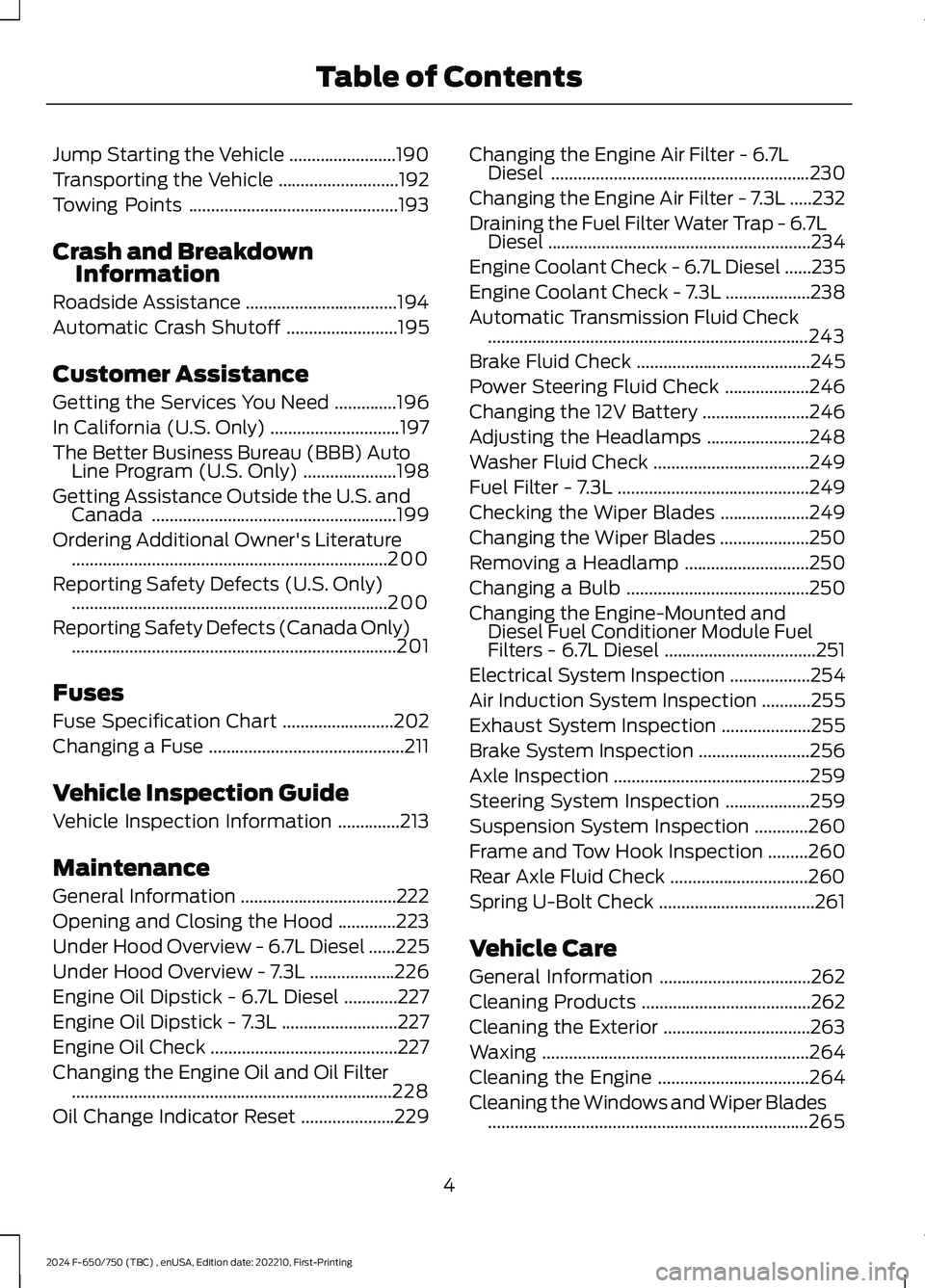
Jump Starting the Vehicle........................190
Transporting the Vehicle...........................192
Towing Points...............................................193
Crash and BreakdownInformation
Roadside Assistance..................................194
Automatic Crash Shutoff.........................195
Customer Assistance
Getting the Services You Need..............196
In California (U.S. Only).............................197
The Better Business Bureau (BBB) AutoLine Program (U.S. Only).....................198
Getting Assistance Outside the U.S. andCanada.......................................................199
Ordering Additional Owner's Literature.......................................................................200
Reporting Safety Defects (U.S. Only).......................................................................200
Reporting Safety Defects (Canada Only).........................................................................201
Fuses
Fuse Specification Chart.........................202
Changing a Fuse............................................211
Vehicle Inspection Guide
Vehicle Inspection Information..............213
Maintenance
General Information...................................222
Opening and Closing the Hood.............223
Under Hood Overview - 6.7L Diesel......225
Under Hood Overview - 7.3L...................226
Engine Oil Dipstick - 6.7L Diesel............227
Engine Oil Dipstick - 7.3L..........................227
Engine Oil Check..........................................227
Changing the Engine Oil and Oil Filter........................................................................228
Oil Change Indicator Reset.....................229
Changing the Engine Air Filter - 6.7LDiesel..........................................................230
Changing the Engine Air Filter - 7.3L.....232
Draining the Fuel Filter Water Trap - 6.7LDiesel...........................................................234
Engine Coolant Check - 6.7L Diesel......235
Engine Coolant Check - 7.3L...................238
Automatic Transmission Fluid Check........................................................................243
Brake Fluid Check.......................................245
Power Steering Fluid Check...................246
Changing the 12V Battery........................246
Adjusting the Headlamps.......................248
Washer Fluid Check...................................249
Fuel Filter - 7.3L...........................................249
Checking the Wiper Blades....................249
Changing the Wiper Blades....................250
Removing a Headlamp............................250
Changing a Bulb.........................................250
Changing the Engine-Mounted andDiesel Fuel Conditioner Module FuelFilters - 6.7L Diesel..................................251
Electrical System Inspection..................254
Air Induction System Inspection...........255
Exhaust System Inspection....................255
Brake System Inspection.........................256
Axle Inspection............................................259
Steering System Inspection...................259
Suspension System Inspection............260
Frame and Tow Hook Inspection.........260
Rear Axle Fluid Check...............................260
Spring U-Bolt Check...................................261
Vehicle Care
General Information..................................262
Cleaning Products......................................262
Cleaning the Exterior.................................263
Waxing............................................................264
Cleaning the Engine..................................264
Cleaning the Windows and Wiper Blades........................................................................265
4
2024 F-650/750 (TBC) , enUSA, Edition date: 202210, First-PrintingTable of Contents
Page 13 of 386
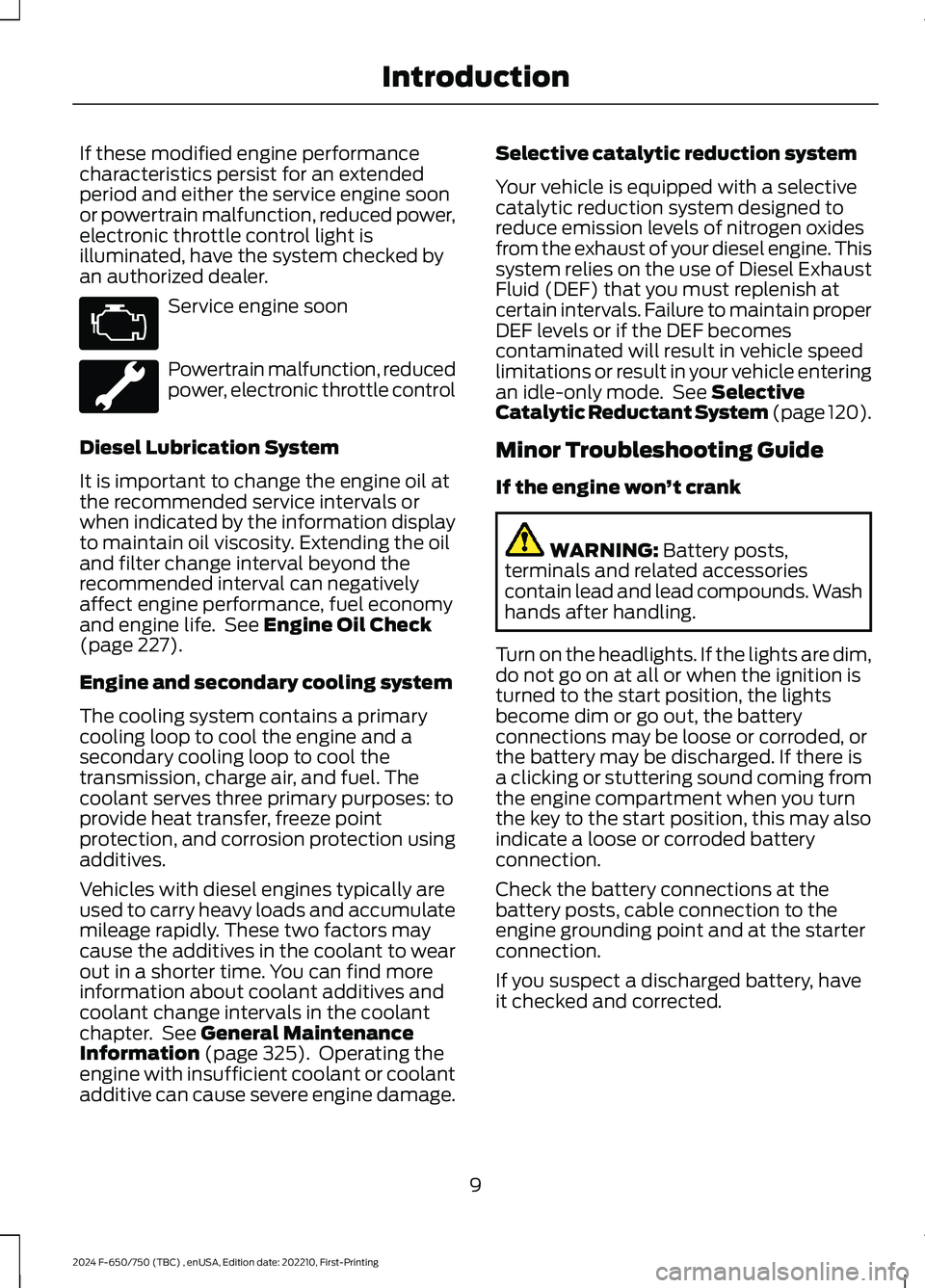
If these modified engine performancecharacteristics persist for an extendedperiod and either the service engine soonor powertrain malfunction, reduced power,electronic throttle control light isilluminated, have the system checked byan authorized dealer.
Service engine soon
Powertrain malfunction, reducedpower, electronic throttle control
Diesel Lubrication System
It is important to change the engine oil atthe recommended service intervals orwhen indicated by the information displayto maintain oil viscosity. Extending the oiland filter change interval beyond therecommended interval can negativelyaffect engine performance, fuel economyand engine life. See Engine Oil Check(page 227).
Engine and secondary cooling system
The cooling system contains a primarycooling loop to cool the engine and asecondary cooling loop to cool thetransmission, charge air, and fuel. Thecoolant serves three primary purposes: toprovide heat transfer, freeze pointprotection, and corrosion protection usingadditives.
Vehicles with diesel engines typically areused to carry heavy loads and accumulatemileage rapidly. These two factors maycause the additives in the coolant to wearout in a shorter time. You can find moreinformation about coolant additives andcoolant change intervals in the coolantchapter. See General MaintenanceInformation (page 325). Operating theengine with insufficient coolant or coolantadditive can cause severe engine damage.
Selective catalytic reduction system
Your vehicle is equipped with a selectivecatalytic reduction system designed toreduce emission levels of nitrogen oxidesfrom the exhaust of your diesel engine. Thissystem relies on the use of Diesel ExhaustFluid (DEF) that you must replenish atcertain intervals. Failure to maintain properDEF levels or if the DEF becomescontaminated will result in vehicle speedlimitations or result in your vehicle enteringan idle-only mode. See SelectiveCatalytic Reductant System (page 120).
Minor Troubleshooting Guide
If the engine won’t crank
WARNING: Battery posts,terminals and related accessoriescontain lead and lead compounds. Washhands after handling.
Turn on the headlights. If the lights are dim,do not go on at all or when the ignition isturned to the start position, the lightsbecome dim or go out, the batteryconnections may be loose or corroded, orthe battery may be discharged. If there isa clicking or stuttering sound coming fromthe engine compartment when you turnthe key to the start position, this may alsoindicate a loose or corroded batteryconnection.
Check the battery connections at thebattery posts, cable connection to theengine grounding point and at the starterconnection.
If you suspect a discharged battery, haveit checked and corrected.
9
2024 F-650/750 (TBC) , enUSA, Edition date: 202210, First-PrintingIntroductionE67028
Page 14 of 386
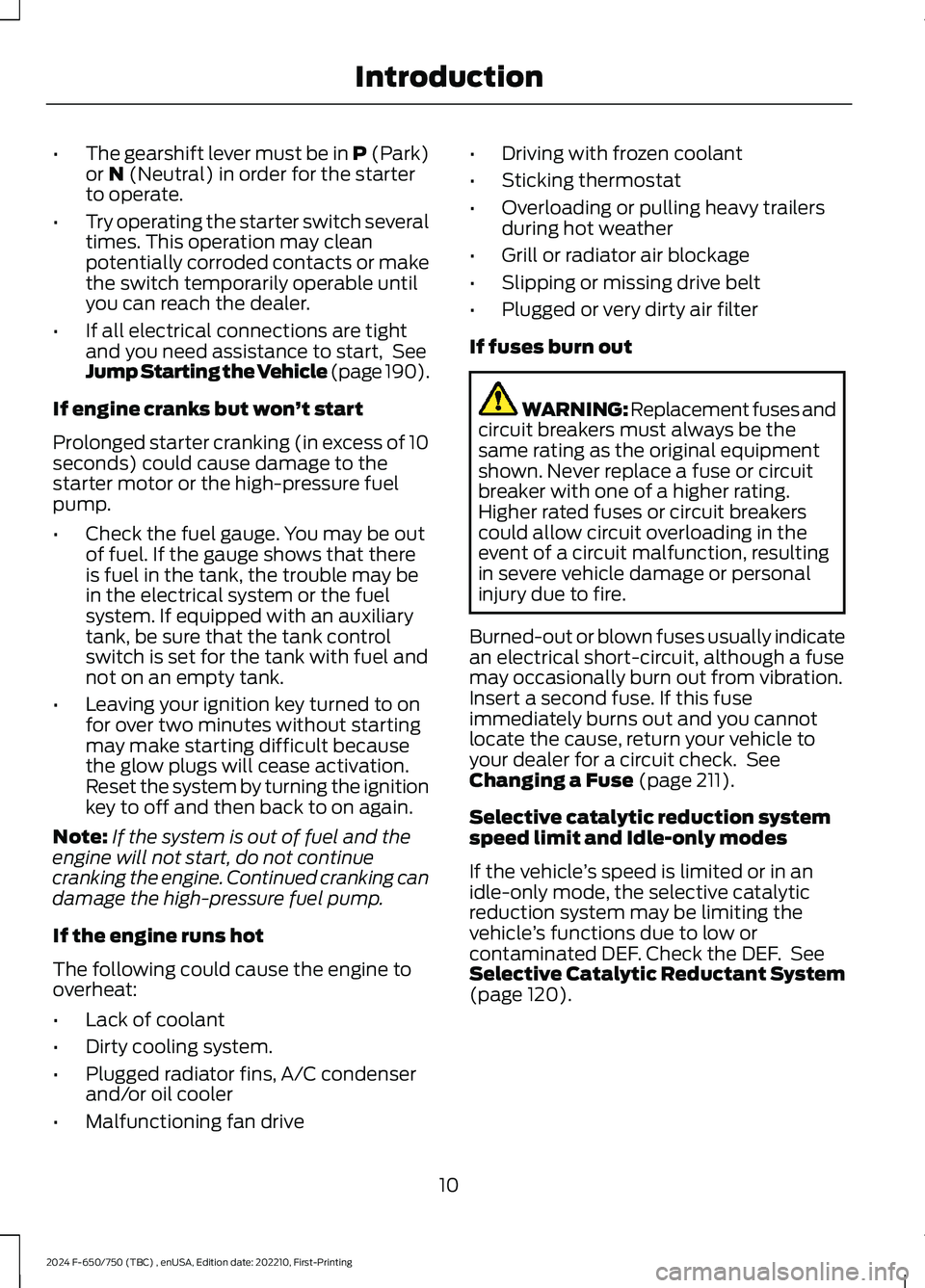
•The gearshift lever must be in P (Park)or N (Neutral) in order for the starterto operate.
•Try operating the starter switch severaltimes. This operation may cleanpotentially corroded contacts or makethe switch temporarily operable untilyou can reach the dealer.
•If all electrical connections are tightand you need assistance to start, SeeJump Starting the Vehicle (page 190).
If engine cranks but won’t start
Prolonged starter cranking (in excess of 10seconds) could cause damage to thestarter motor or the high-pressure fuelpump.
•Check the fuel gauge. You may be outof fuel. If the gauge shows that thereis fuel in the tank, the trouble may bein the electrical system or the fuelsystem. If equipped with an auxiliarytank, be sure that the tank controlswitch is set for the tank with fuel andnot on an empty tank.
•Leaving your ignition key turned to onfor over two minutes without startingmay make starting difficult becausethe glow plugs will cease activation.Reset the system by turning the ignitionkey to off and then back to on again.
Note:If the system is out of fuel and theengine will not start, do not continuecranking the engine. Continued cranking candamage the high-pressure fuel pump.
If the engine runs hot
The following could cause the engine tooverheat:
•Lack of coolant
•Dirty cooling system.
•Plugged radiator fins, A/C condenserand/or oil cooler
•Malfunctioning fan drive
•Driving with frozen coolant
•Sticking thermostat
•Overloading or pulling heavy trailersduring hot weather
•Grill or radiator air blockage
•Slipping or missing drive belt
•Plugged or very dirty air filter
If fuses burn out
WARNING: Replacement fuses andcircuit breakers must always be thesame rating as the original equipmentshown. Never replace a fuse or circuitbreaker with one of a higher rating.Higher rated fuses or circuit breakerscould allow circuit overloading in theevent of a circuit malfunction, resultingin severe vehicle damage or personalinjury due to fire.
Burned-out or blown fuses usually indicatean electrical short-circuit, although a fusemay occasionally burn out from vibration.Insert a second fuse. If this fuseimmediately burns out and you cannotlocate the cause, return your vehicle toyour dealer for a circuit check. SeeChanging a Fuse (page 211).
Selective catalytic reduction systemspeed limit and Idle-only modes
If the vehicle’s speed is limited or in anidle-only mode, the selective catalyticreduction system may be limiting thevehicle’s functions due to low orcontaminated DEF. Check the DEF. SeeSelective Catalytic Reductant System(page 120).
10
2024 F-650/750 (TBC) , enUSA, Edition date: 202210, First-PrintingIntroduction
Page 23 of 386
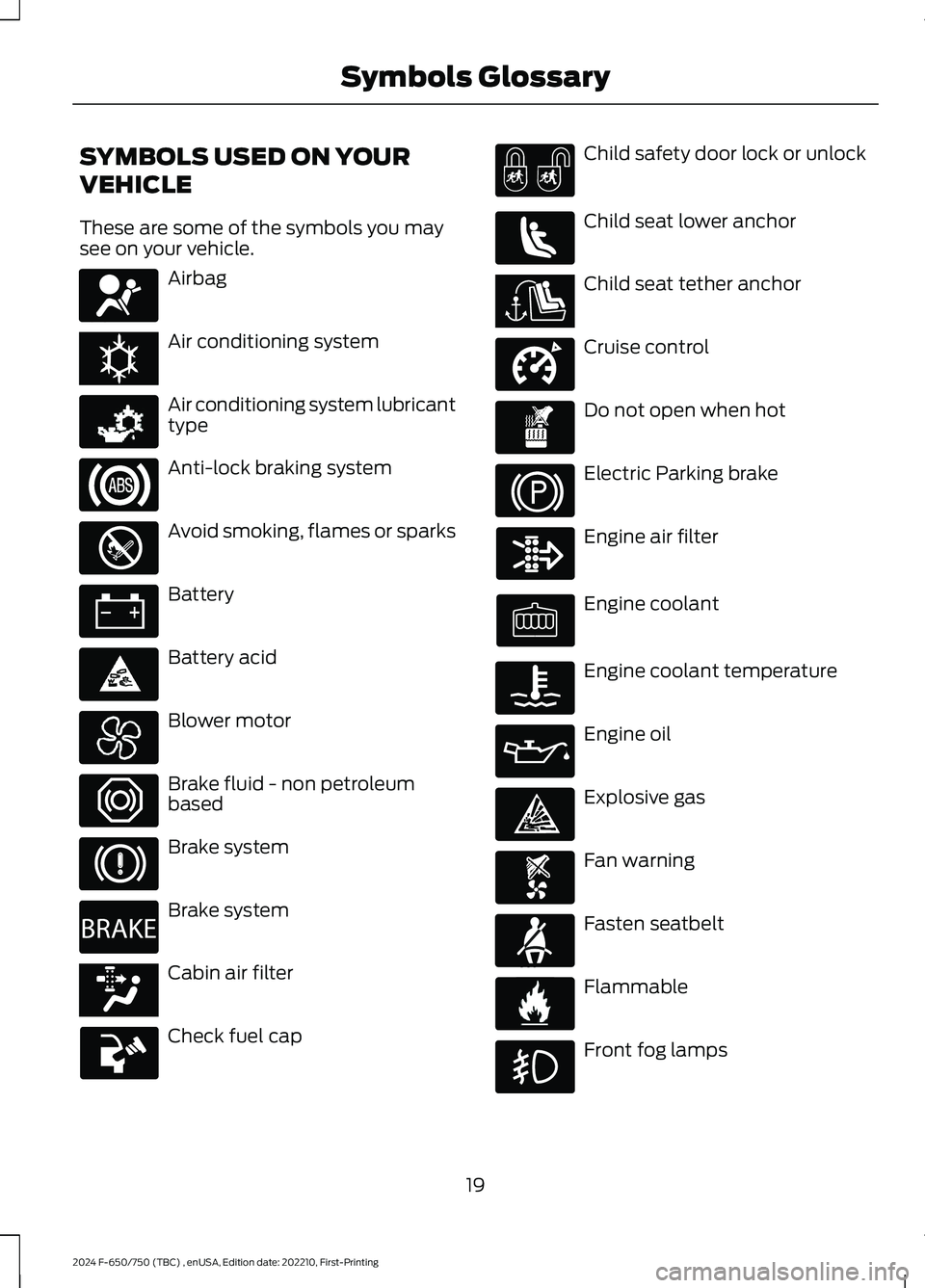
SYMBOLS USED ON YOUR
VEHICLE
These are some of the symbols you maysee on your vehicle.
Airbag
Air conditioning system
Air conditioning system lubricanttype
Anti-lock braking system
Avoid smoking, flames or sparks
Battery
Battery acid
Blower motor
Brake fluid - non petroleumbased
Brake system
Brake system
Cabin air filter
Check fuel cap
Child safety door lock or unlock
Child seat lower anchor
Child seat tether anchor
Cruise control
Do not open when hot
Electric Parking brake
Engine air filter
Engine coolant
Engine coolant temperature
Engine oil
Explosive gas
Fan warning
Fasten seatbelt
Flammable
Front fog lamps
19
2024 F-650/750 (TBC) , enUSA, Edition date: 202210, First-PrintingSymbols GlossaryE67017 E162384 E231157 E67020 E139220 E67021 E139227 E139209 E67024 E270480 E139223 E139211 E141128 E332905 E139219 E139212 E103308 E67022 E139221 E139228 E71880 E231160
Page 26 of 386
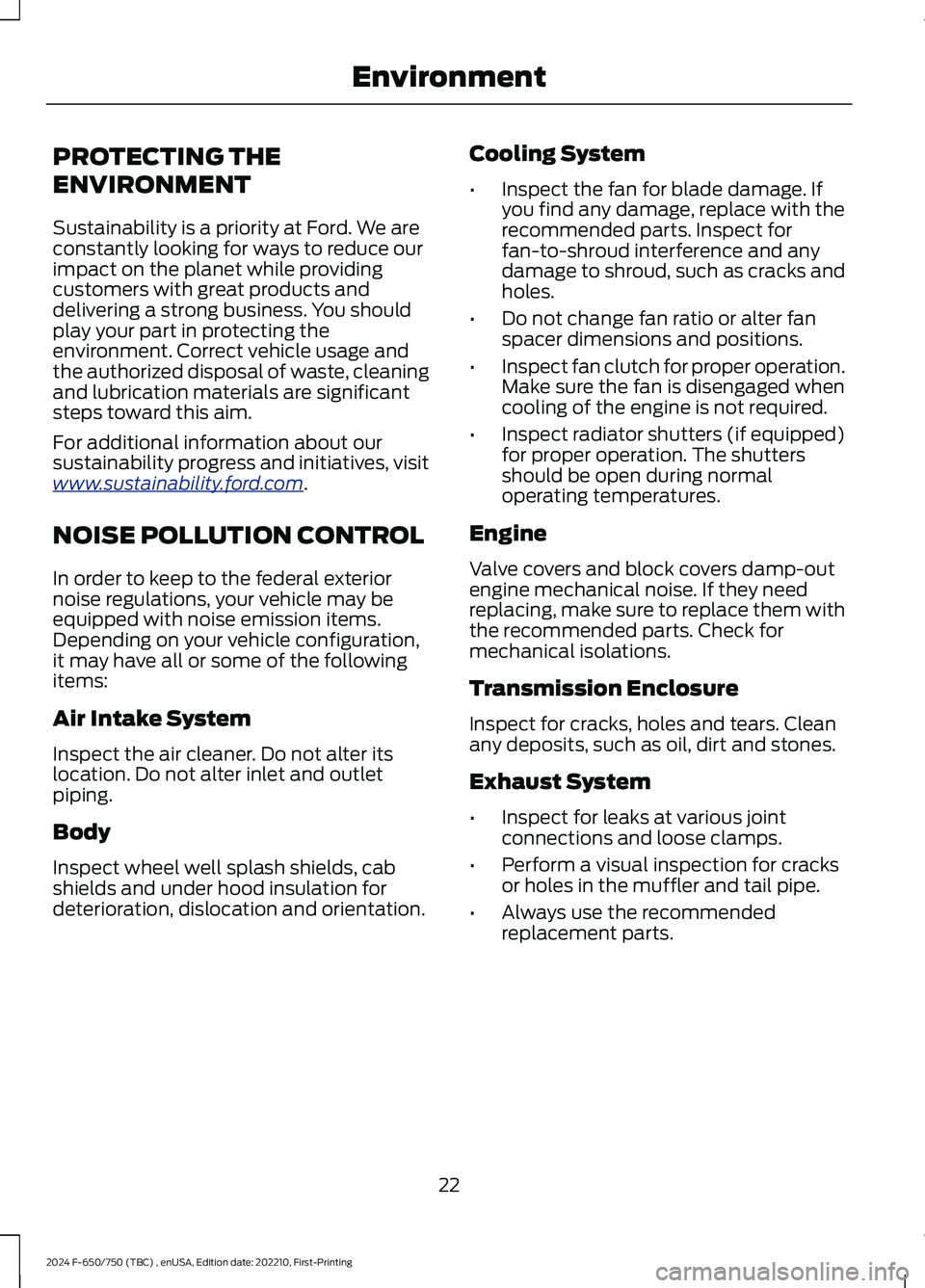
PROTECTING THE
ENVIRONMENT
Sustainability is a priority at Ford. We areconstantly looking for ways to reduce ourimpact on the planet while providingcustomers with great products anddelivering a strong business. You shouldplay your part in protecting theenvironment. Correct vehicle usage andthe authorized disposal of waste, cleaningand lubrication materials are significantsteps toward this aim.
For additional information about oursustainability progress and initiatives, visitwww.sustainability.ford.com.
NOISE POLLUTION CONTROL
In order to keep to the federal exteriornoise regulations, your vehicle may beequipped with noise emission items.Depending on your vehicle configuration,it may have all or some of the followingitems:
Air Intake System
Inspect the air cleaner. Do not alter itslocation. Do not alter inlet and outletpiping.
Body
Inspect wheel well splash shields, cabshields and under hood insulation fordeterioration, dislocation and orientation.
Cooling System
•Inspect the fan for blade damage. Ifyou find any damage, replace with therecommended parts. Inspect forfan-to-shroud interference and anydamage to shroud, such as cracks andholes.
•Do not change fan ratio or alter fanspacer dimensions and positions.
•Inspect fan clutch for proper operation.Make sure the fan is disengaged whencooling of the engine is not required.
•Inspect radiator shutters (if equipped)for proper operation. The shuttersshould be open during normaloperating temperatures.
Engine
Valve covers and block covers damp-outengine mechanical noise. If they needreplacing, make sure to replace them withthe recommended parts. Check formechanical isolations.
Transmission Enclosure
Inspect for cracks, holes and tears. Cleanany deposits, such as oil, dirt and stones.
Exhaust System
•Inspect for leaks at various jointconnections and loose clamps.
•Perform a visual inspection for cracksor holes in the muffler and tail pipe.
•Always use the recommendedreplacement parts.
22
2024 F-650/750 (TBC) , enUSA, Edition date: 202210, First-PrintingEnvironment
Page 70 of 386
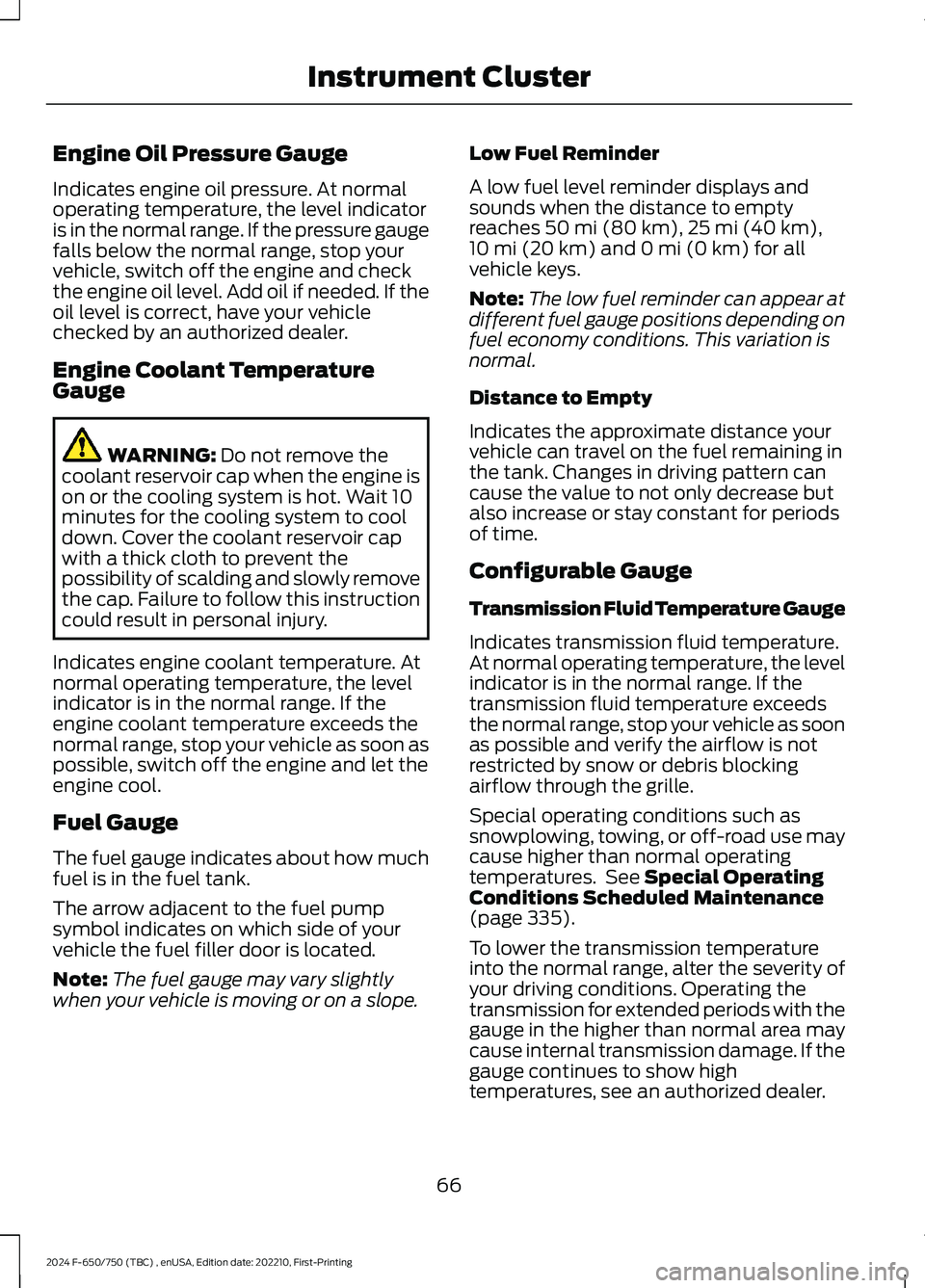
Engine Oil Pressure Gauge
Indicates engine oil pressure. At normaloperating temperature, the level indicatoris in the normal range. If the pressure gaugefalls below the normal range, stop yourvehicle, switch off the engine and checkthe engine oil level. Add oil if needed. If theoil level is correct, have your vehiclechecked by an authorized dealer.
Engine Coolant TemperatureGauge
WARNING: Do not remove thecoolant reservoir cap when the engine ison or the cooling system is hot. Wait 10minutes for the cooling system to cooldown. Cover the coolant reservoir capwith a thick cloth to prevent thepossibility of scalding and slowly removethe cap. Failure to follow this instructioncould result in personal injury.
Indicates engine coolant temperature. Atnormal operating temperature, the levelindicator is in the normal range. If theengine coolant temperature exceeds thenormal range, stop your vehicle as soon aspossible, switch off the engine and let theengine cool.
Fuel Gauge
The fuel gauge indicates about how muchfuel is in the fuel tank.
The arrow adjacent to the fuel pumpsymbol indicates on which side of yourvehicle the fuel filler door is located.
Note:The fuel gauge may vary slightlywhen your vehicle is moving or on a slope.
Low Fuel Reminder
A low fuel level reminder displays andsounds when the distance to emptyreaches 50 mi (80 km),25 mi (40 km),10 mi (20 km) and 0 mi (0 km) for allvehicle keys.
Note:The low fuel reminder can appear atdifferent fuel gauge positions depending onfuel economy conditions. This variation isnormal.
Distance to Empty
Indicates the approximate distance yourvehicle can travel on the fuel remaining inthe tank. Changes in driving pattern cancause the value to not only decrease butalso increase or stay constant for periodsof time.
Configurable Gauge
Transmission Fluid Temperature Gauge
Indicates transmission fluid temperature.At normal operating temperature, the levelindicator is in the normal range. If thetransmission fluid temperature exceedsthe normal range, stop your vehicle as soonas possible and verify the airflow is notrestricted by snow or debris blockingairflow through the grille.
Special operating conditions such assnowplowing, towing, or off-road use maycause higher than normal operatingtemperatures. See Special OperatingConditions Scheduled Maintenance(page 335).
To lower the transmission temperatureinto the normal range, alter the severity ofyour driving conditions. Operating thetransmission for extended periods with thegauge in the higher than normal area maycause internal transmission damage. If thegauge continues to show hightemperatures, see an authorized dealer.
66
2024 F-650/750 (TBC) , enUSA, Edition date: 202210, First-PrintingInstrument Cluster
Page 72 of 386
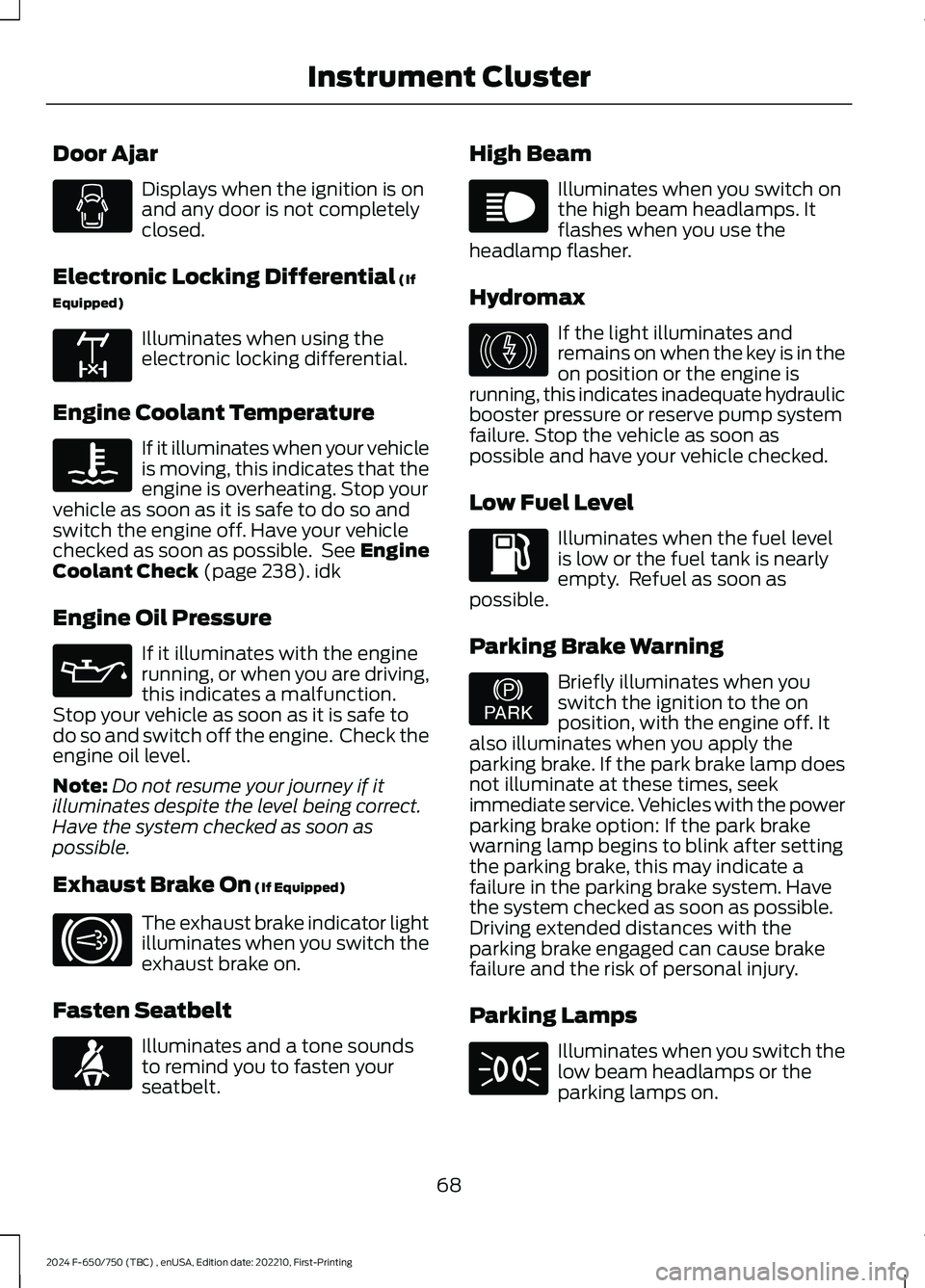
Door Ajar
Displays when the ignition is onand any door is not completelyclosed.
Electronic Locking Differential (If
Equipped)
Illuminates when using theelectronic locking differential.
Engine Coolant Temperature
If it illuminates when your vehicleis moving, this indicates that theengine is overheating. Stop yourvehicle as soon as it is safe to do so andswitch the engine off. Have your vehiclechecked as soon as possible. See EngineCoolant Check (page 238).idk
Engine Oil Pressure
If it illuminates with the enginerunning, or when you are driving,this indicates a malfunction.Stop your vehicle as soon as it is safe todo so and switch off the engine. Check theengine oil level.
Note:Do not resume your journey if itilluminates despite the level being correct.Have the system checked as soon aspossible.
Exhaust Brake On (If Equipped)
The exhaust brake indicator lightilluminates when you switch theexhaust brake on.
Fasten Seatbelt
Illuminates and a tone soundsto remind you to fasten yourseatbelt.
High Beam
Illuminates when you switch onthe high beam headlamps. Itflashes when you use theheadlamp flasher.
Hydromax
If the light illuminates andremains on when the key is in theon position or the engine isrunning, this indicates inadequate hydraulicbooster pressure or reserve pump systemfailure. Stop the vehicle as soon aspossible and have your vehicle checked.
Low Fuel Level
Illuminates when the fuel levelis low or the fuel tank is nearlyempty. Refuel as soon aspossible.
Parking Brake Warning
Briefly illuminates when youswitch the ignition to the onposition, with the engine off. Italso illuminates when you apply theparking brake. If the park brake lamp doesnot illuminate at these times, seekimmediate service. Vehicles with the powerparking brake option: If the park brakewarning lamp begins to blink after settingthe parking brake, this may indicate afailure in the parking brake system. Havethe system checked as soon as possible.Driving extended distances with theparking brake engaged can cause brakefailure and the risk of personal injury.
Parking Lamps
Illuminates when you switch thelow beam headlamps or theparking lamps on.
68
2024 F-650/750 (TBC) , enUSA, Edition date: 202210, First-PrintingInstrument Cluster E163170 E103308 E67022 E171217 E71880 E67019 E146190 E208810 E71341
Page 73 of 386
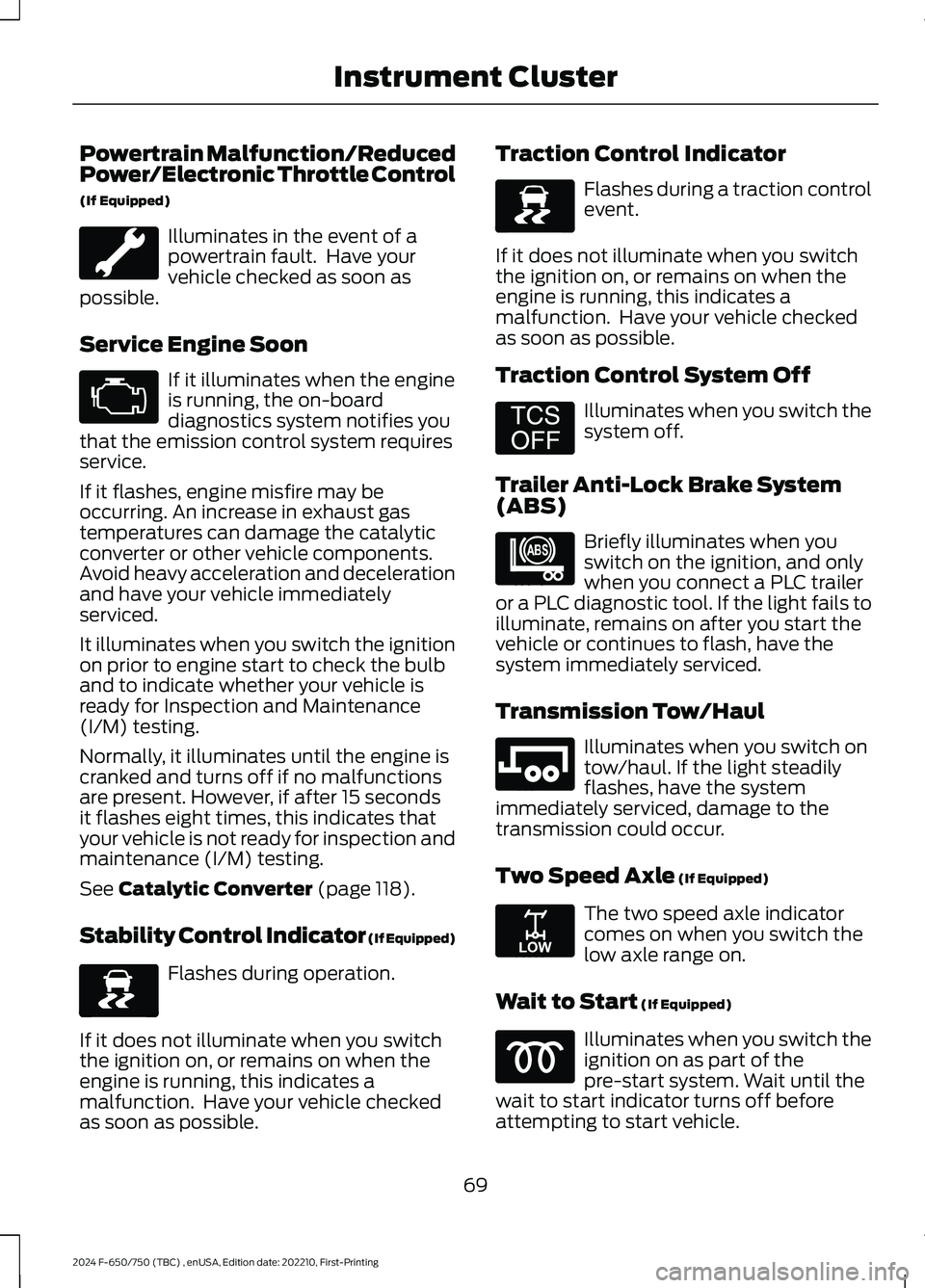
Powertrain Malfunction/ReducedPower/Electronic Throttle Control
(If Equipped)
Illuminates in the event of apowertrain fault. Have yourvehicle checked as soon aspossible.
Service Engine Soon
If it illuminates when the engineis running, the on-boarddiagnostics system notifies youthat the emission control system requiresservice.
If it flashes, engine misfire may beoccurring. An increase in exhaust gastemperatures can damage the catalyticconverter or other vehicle components.Avoid heavy acceleration and decelerationand have your vehicle immediatelyserviced.
It illuminates when you switch the ignitionon prior to engine start to check the bulband to indicate whether your vehicle isready for Inspection and Maintenance(I/M) testing.
Normally, it illuminates until the engine iscranked and turns off if no malfunctionsare present. However, if after 15 secondsit flashes eight times, this indicates thatyour vehicle is not ready for inspection andmaintenance (I/M) testing.
See Catalytic Converter (page 118).
Stability Control Indicator (If Equipped)
Flashes during operation.
If it does not illuminate when you switchthe ignition on, or remains on when theengine is running, this indicates amalfunction. Have your vehicle checkedas soon as possible.
Traction Control Indicator
Flashes during a traction controlevent.
If it does not illuminate when you switchthe ignition on, or remains on when theengine is running, this indicates amalfunction. Have your vehicle checkedas soon as possible.
Traction Control System Off
Illuminates when you switch thesystem off.
Trailer Anti-Lock Brake System(ABS)
Briefly illuminates when youswitch on the ignition, and onlywhen you connect a PLC traileror a PLC diagnostic tool. If the light fails toilluminate, remains on after you start thevehicle or continues to flash, have thesystem immediately serviced.
Transmission Tow/Haul
Illuminates when you switch ontow/haul. If the light steadilyflashes, have the systemimmediately serviced, damage to thetransmission could occur.
Two Speed Axle (If Equipped)
The two speed axle indicatorcomes on when you switch thelow axle range on.
Wait to Start (If Equipped)
Illuminates when you switch theignition on as part of thepre-start system. Wait until thewait to start indicator turns off beforeattempting to start vehicle.
69
2024 F-650/750 (TBC) , enUSA, Edition date: 202210, First-PrintingInstrument Cluster E67028 E138639 E138639 E194301 E209040 E246592 E208809
Page 74 of 386
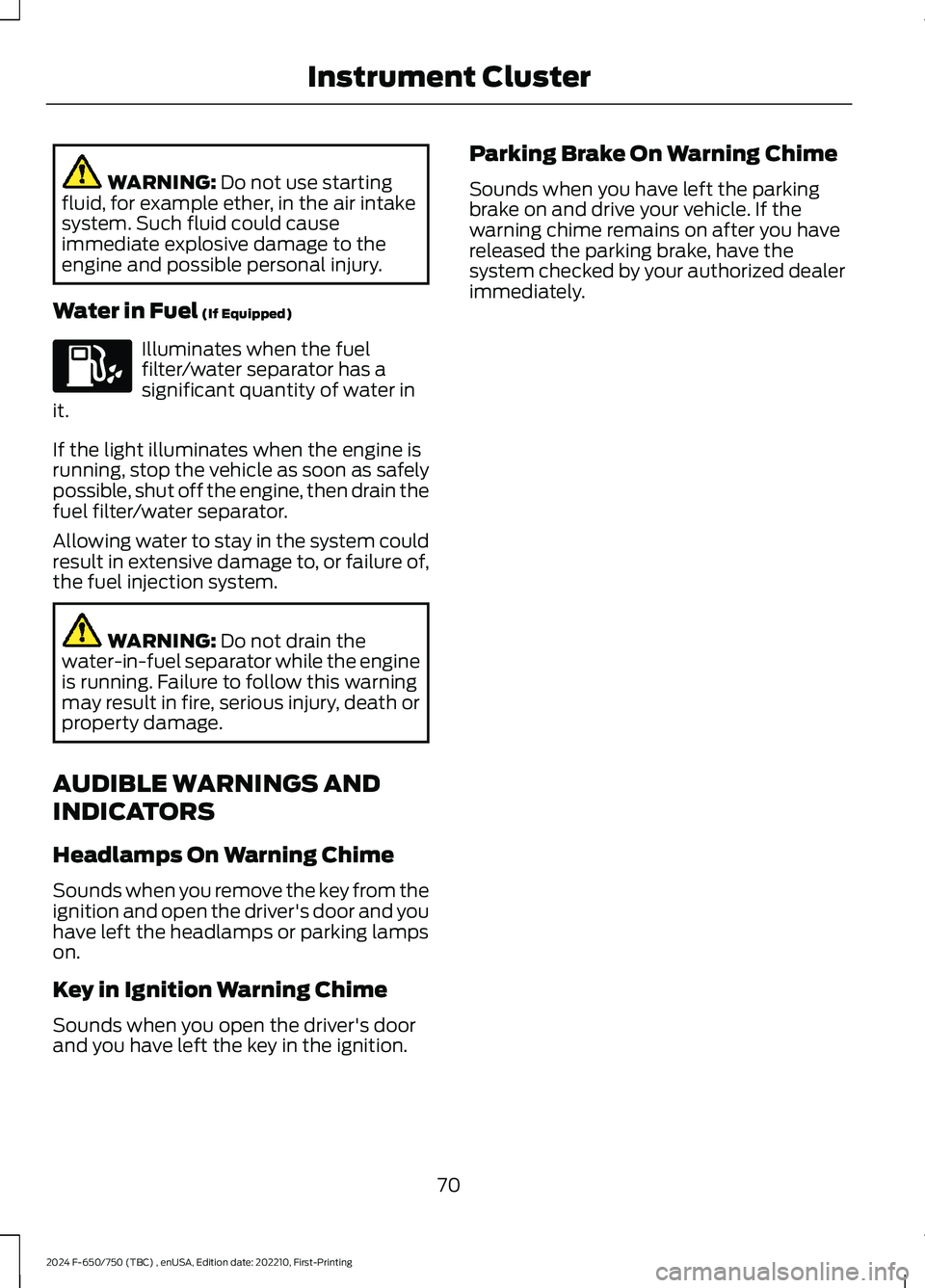
WARNING: Do not use startingfluid, for example ether, in the air intakesystem. Such fluid could causeimmediate explosive damage to theengine and possible personal injury.
Water in Fuel (If Equipped)
Illuminates when the fuelfilter/water separator has asignificant quantity of water init.
If the light illuminates when the engine isrunning, stop the vehicle as soon as safelypossible, shut off the engine, then drain thefuel filter/water separator.
Allowing water to stay in the system couldresult in extensive damage to, or failure of,the fuel injection system.
WARNING: Do not drain thewater-in-fuel separator while the engineis running. Failure to follow this warningmay result in fire, serious injury, death orproperty damage.
AUDIBLE WARNINGS AND
INDICATORS
Headlamps On Warning Chime
Sounds when you remove the key from theignition and open the driver's door and youhave left the headlamps or parking lampson.
Key in Ignition Warning Chime
Sounds when you open the driver's doorand you have left the key in the ignition.
Parking Brake On Warning Chime
Sounds when you have left the parkingbrake on and drive your vehicle. If thewarning chime remains on after you havereleased the parking brake, have thesystem checked by your authorized dealerimmediately.
70
2024 F-650/750 (TBC) , enUSA, Edition date: 202210, First-PrintingInstrument Cluster
Page 82 of 386
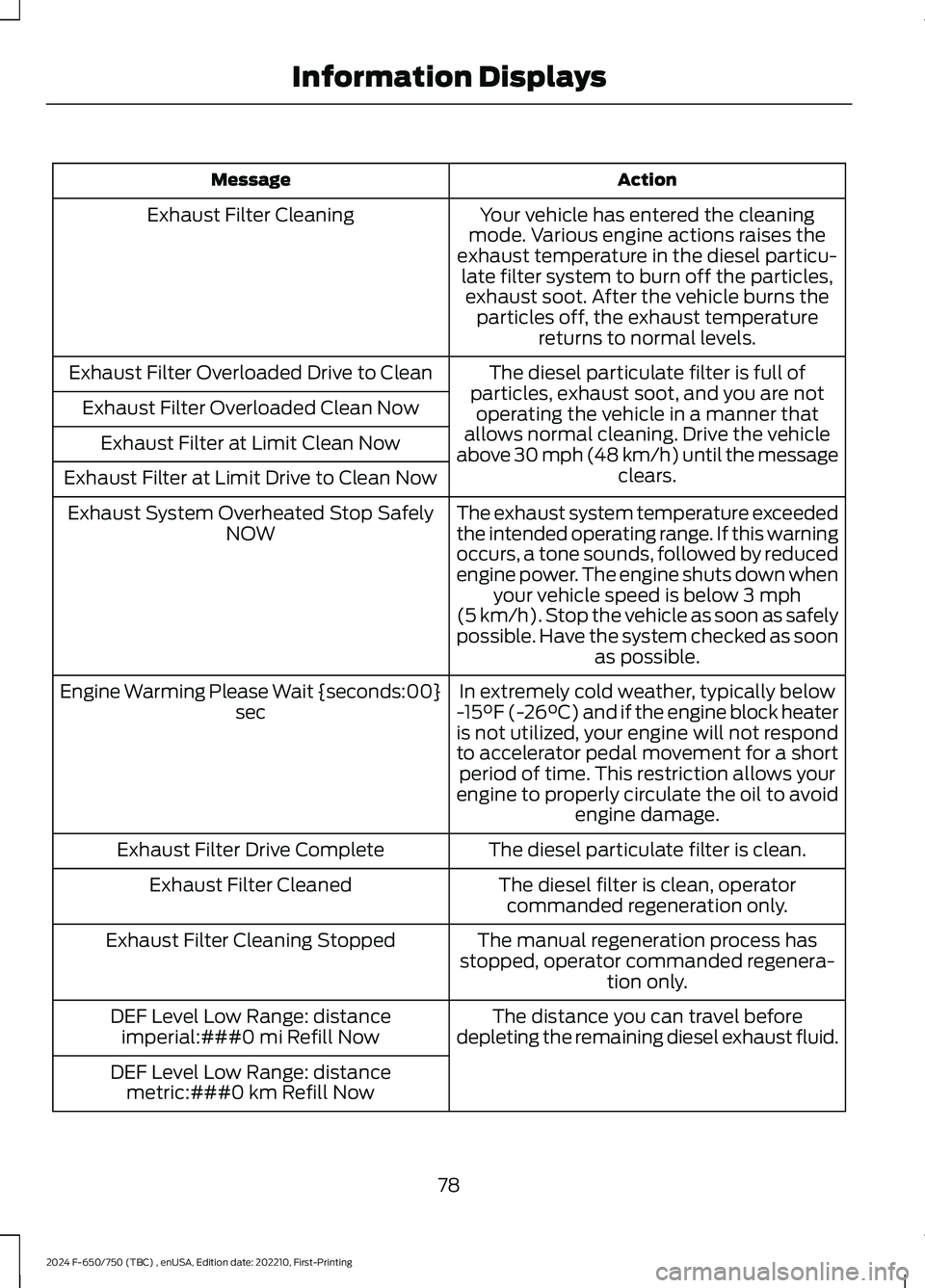
ActionMessage
Your vehicle has entered the cleaningmode. Various engine actions raises theexhaust temperature in the diesel particu-late filter system to burn off the particles,exhaust soot. After the vehicle burns theparticles off, the exhaust temperaturereturns to normal levels.
Exhaust Filter Cleaning
The diesel particulate filter is full ofparticles, exhaust soot, and you are notoperating the vehicle in a manner thatallows normal cleaning. Drive the vehicleabove 30 mph (48 km/h) until the messageclears.
Exhaust Filter Overloaded Drive to Clean
Exhaust Filter Overloaded Clean Now
Exhaust Filter at Limit Clean Now
Exhaust Filter at Limit Drive to Clean Now
The exhaust system temperature exceededthe intended operating range. If this warningoccurs, a tone sounds, followed by reducedengine power. The engine shuts down whenyour vehicle speed is below 3 mph(5 km/h). Stop the vehicle as soon as safelypossible. Have the system checked as soonas possible.
Exhaust System Overheated Stop SafelyNOW
In extremely cold weather, typically below-15°F (-26°C) and if the engine block heateris not utilized, your engine will not respondto accelerator pedal movement for a shortperiod of time. This restriction allows yourengine to properly circulate the oil to avoidengine damage.
Engine Warming Please Wait {seconds:00}sec
The diesel particulate filter is clean.Exhaust Filter Drive Complete
The diesel filter is clean, operatorcommanded regeneration only.Exhaust Filter Cleaned
The manual regeneration process hasstopped, operator commanded regenera-tion only.
Exhaust Filter Cleaning Stopped
The distance you can travel beforedepleting the remaining diesel exhaust fluid.DEF Level Low Range: distanceimperial:###0 mi Refill Now
DEF Level Low Range: distancemetric:###0 km Refill Now
78
2024 F-650/750 (TBC) , enUSA, Edition date: 202210, First-PrintingInformation Displays